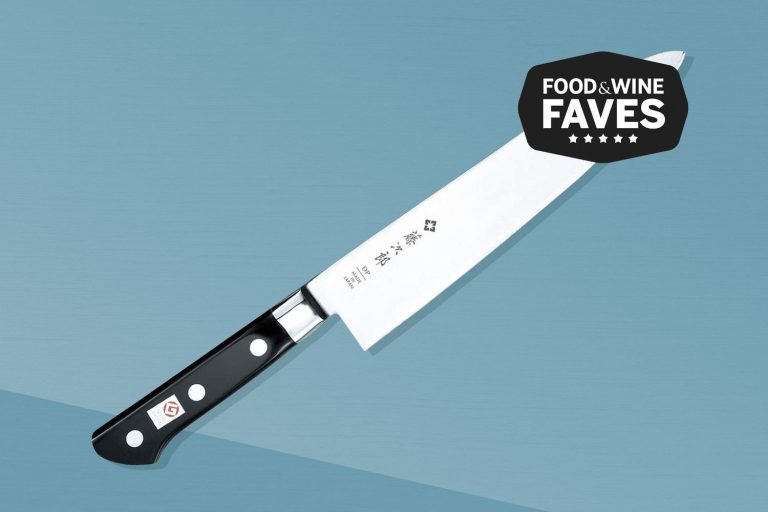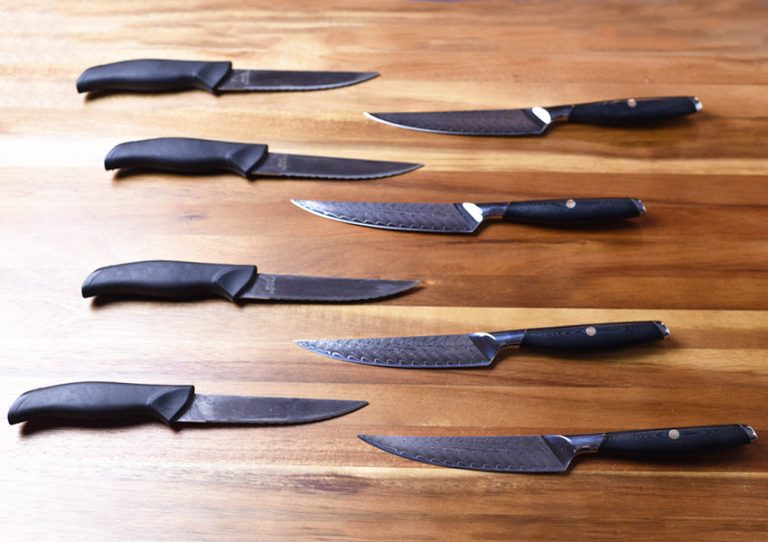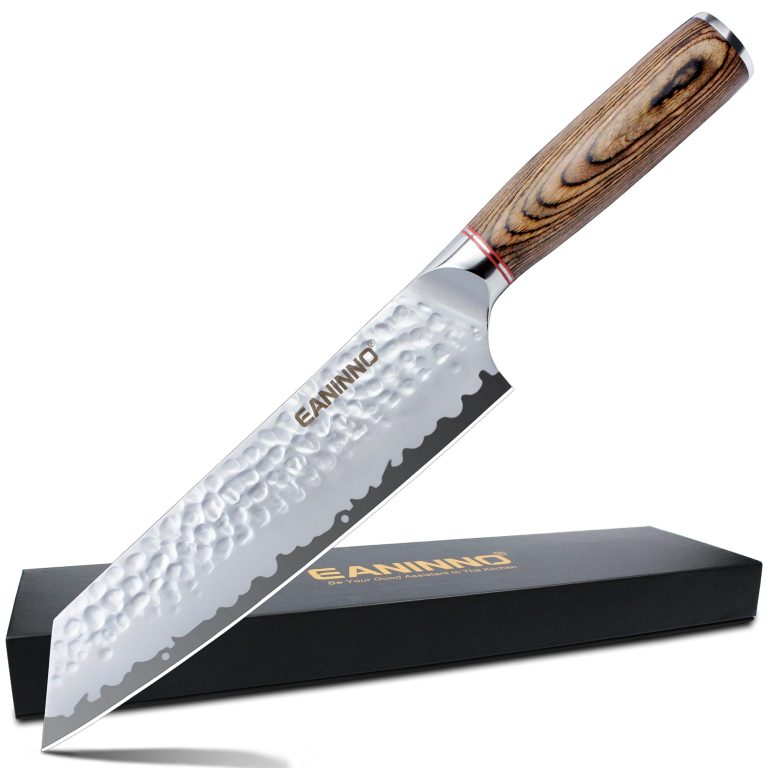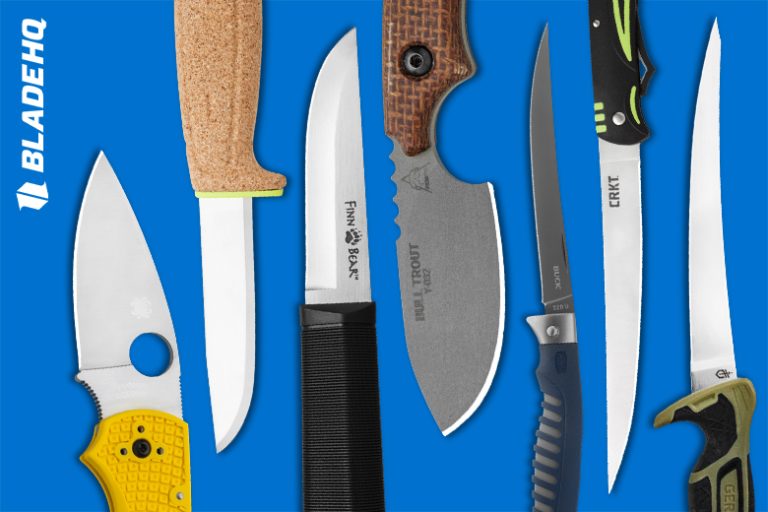Japanese Vs German Knives : Unleashing the Ultimate Battle
Japanese knives are known for their thin and precise blades, while German knives are renowned for their durability and versatility. When it comes to choosing the right knife for your kitchen, understanding the differences between Japanese and German knives is essential.
Japanese knives are known for their thin and precise blades, which provide exceptional cutting performance. The blades are typically made from a harder type of steel, allowing for a sharper edge and better edge retention. On the other hand, German knives are recognized for their durability and versatility.
They often have a thicker blade, which provides more weight and stability during cutting tasks. German knives are also known for their full tang construction, where the blade extends through the handle for added strength. By considering your cooking style and preferences, you can choose between the elegance of Japanese knives or the resilience of German ones
The History And Tradition Of Japanese Knives
The history and tradition of Japanese knives are deeply rooted in the legacy of Samurai craftsmanship. These knives have garnered a worldwide reputation for their exceptional quality and precision. Traditional Japanese knife-making techniques have been honed over centuries, passed down from generation to generation.
One notable aspect of these knives is the meticulous attention to detail. Expert craftsmen take pride in forging each blade with the utmost care and precision. The process involves heating and hammering high-carbon steel repeatedly to achieve a strong, sharp, and durable blade. This intricate technique ensures that the knife can retain its edge for extended periods.
Japanese knives also boast unique design features. The iconic single-bevel edge allows for refined slicing and precision cuts. Different types of Japanese knives serve specific purposes, such as the Yanagiba for slicing raw fish and the Santoku for general food preparation.
Overall, the history, tradition, and craftsmanship behind Japanese knives make them distinct and highly sought-after in the culinary world.
The Precision And Beauty Of Japanese Knives
“`htmlJapanese knives are renowned for their precision and beauty. Crafted with exquisite artistry and meticulous attention to detail, these knives are a testament to Japanese craftsmanship. One of the distinguishing features of Japanese knives is the high-quality materials used in their construction. From the blade to the handle, every component is carefully chosen to ensure durability and performance.
| Japanese Knives: Exquisite Artistry and Attention to Detail | The High-Quality Materials Used in Japanese Knives | Japanese Knives: Unparalleled Sharpness and Cutting Performance |
|---|---|---|
| ✓ Precision craftsmanship | ✓ High-quality materials for durability | ✓ Unparalleled sharpness |
| ✓ Meticulous attention to detail | ✓ Carefully chosen components | ✓ Exceptional cutting performance |
| ✓ Exquisite design | ✓ Ensures longevity | ✓ Cuts through ingredients effortlessly |
Another notable characteristic of Japanese knives is their unparalleled sharpness. The blades are honed to a razor-like edge, allowing for precise and effortless cutting. Whether it’s slicing through vegetables or filleting fish, Japanese knives deliver exceptional cutting performance.
In summary, Japanese knives possess a unique combination of exquisite artistry, attention to detail, high-quality materials, and unparalleled sharpness. These qualities make them a must-have for both professional chefs and cooking enthusiasts who value precision, beauty, and top-notch performance in their culinary tools.
“`The German Approach To Knife Making
German knives are renowned worldwide for their exceptional quality and craftsmanship. They represent the perfect blend of tradition and modernity, making them the go-to choice for professional chefs and cooking enthusiasts alike.
One key element that sets German knives apart is the use of high-quality stainless steel in their blade construction. This material ensures superior sharpness, corrosion resistance, and ease of maintenance. German blades are known for their **resilience and durability**, making them suitable for heavy-duty tasks that require precision and strength.
German knives are carefully crafted, paying attention to every detail. The manufacturers combine traditional techniques with cutting-edge technology to create blades that offer unmatched performance in the kitchen. From the well-balanced handles to the intricate designs, German knives are a true work of art.
Comparing The Blade Styles Of Japanese And German Knives
Japanese knives are renowned for their thin, razor-sharp edges, which allow them to effortlessly slice through food with precision. These knives are crafted using traditional Japanese blade-making techniques, resulting in exceptional sharpness and cutting performance.
On the other hand, German knives are known for their thick, sturdy blades, which provide durability and strength. These knives are designed to handle heavier tasks and are ideal for chopping, slicing, and dicing.
Both Japanese and German knives come in different blade shapes and designs to cater to various cutting needs. Japanese knives often feature a curved blade, such as the popular santoku or gyuto, which allows for more precise cutting and slicing. German knives, on the other hand, typically have a more pronounced curve towards the tip, which facilitates a rocking motion when cutting.
It’s important to consider your specific cutting preferences and needs when choosing between Japanese and German knives. Whether you value the precision and finesse of Japanese knives or the durability and versatility of German knives, both styles have their unique advantages that can enhance your culinary experience.
Performance And Functionality: Japanese Vs German Knives
The debate between Japanese and German knives is a fierce one, with both sides having their own set of merits. Japanese knives are known for their perfect precision and agility. These knives are razor-sharp, allowing for intricate and delicate cuts. They excel in tasks that require finesse, such as slicing sushi or filleting fish.
On the other hand, German knives are all about power and versatility. They are built to handle heavy-duty tasks like chopping through bones or slicing through thick cuts of meat. German knives have a thicker and heavier blade, which gives them stability and strength.
When it comes to choosing the best knife for different cooking techniques and ingredients, it depends on your personal preferences and needs. For precision cuts and delicate ingredients, Japanese knives are the way to go. But if you need a workhorse in the kitchen that can handle any task, German knives are the better choice. Ultimately, it’s about finding the knife that feels comfortable in your hand and suits your cooking style.
| Japanese Knives | German Knives |
|---|---|
| Perfect precision and agility | Power and versatility for chopping and slicing |
| Razor-sharp blades | Thicker and heavier blades |
| Ideal for precision cuts and delicate ingredients | Great for heavy-duty tasks and thicker cuts |

Credit: www.etsy.com
Maintenance And Care: Japanese Vs German Knives
Maintaining the edge of Japanese knives is crucial to their performance and longevity. These knives are known for their exceptional sharpness, which requires careful attention and regular maintenance. To keep the edge razor-sharp, it’s important to regularly hone the blade using a honing rod or sharpening stone. This helps to straighten any microscopic bends in the edge and maintain its sharpness.
On the other hand, caring for German knives involves both honing and sharpening techniques. Honing the blade frequently helps to realign the edge, keeping it in optimal condition. However, over time, the blade may require sharpening to restore its sharpness. Using a whetstone or a professional sharpening service can help to achieve this.
Both Japanese and German knives have distinct maintenance requirements. By understanding the specific needs of each type, knife enthusiasts can ensure that their prized tools stay sharp and perform at their best for years to come.
The Price Factor: Japanese Vs German Knives
Japanese knives are renowned for their exceptional craftsmanship and attention to detail, and this level of precision comes at a premium price. Handcrafted by skilled artisans, these knives are made using traditional techniques that have been passed down for generations. They are made from high-quality materials, such as high-carbon steel, which ensures superior sharpness and long-lasting performance. Due to their meticulous craftsmanship and superior quality, Japanese knives tend to be on the higher end of the price spectrum.
On the other hand, German knives offer a balance of quality and affordability. Made using modern manufacturing processes, these knives are known for their durability and functionality. German knives are typically made from stainless steel and are designed with a robust construction, making them suitable for heavy-duty tasks in the kitchen. While they may not possess the same level of precision as their Japanese counterparts, German knives are more accessible in terms of price and offer excellent value for money.
Ultimately, the choice between Japanese and German knives boils down to personal preference, budget, and the specific requirements of the user. Whether you opt for the intricate craftsmanship of Japanese knives or the durability and affordability of German knives, both options are capable of delivering exceptional cutting performance.
Which Knife Should You Choose: Japanese Or German?
When deciding between Japanese and German knives, it’s important to understand your own cooking style and preferences. Consider the following factors to help make your decision:
- Blade Design: Japanese knives typically have a thinner and sharper blade, ideal for precision slicing and dicing. German knives, on the other hand, have a thicker and heavier blade, making them more suitable for tasks that require chopping and mincing.
- Hardness: Japanese knives are known for their high hardness due to the use of hard carbon steel. This makes them extremely sharp and able to hold their edge for longer periods. German knives, meanwhile, are generally made of softer steel, offering more flexibility but requiring more frequent honing.
- Handle Style: Japanese knives often have a wooden handle, which provides a traditional and ergonomic grip. German knives commonly feature a full tang and a heavier handle made of synthetic or composite materials, offering a more substantial feel.
- Price: Japanese knives are typically more expensive due to their craftsmanship and materials. German knives, on the other hand, are more affordable and offer a great balance between quality and value.
- Maintenance: Japanese knives require special care, as they are prone to rust and may need regular sharpening. German knives are generally more forgiving in terms of maintenance and are dishwasher-safe.
- Personal Preference: Ultimately, the best knife for you depends on your personal preference and cooking style. Consider trying out different knives and handling them to see which one feels more comfortable and suits your needs.
Conclusion
To sum up, both Japanese and German knives have their own unique qualities that make them popular choices among professional chefs and cooking enthusiasts. While Japanese knives are known for their sharpness, precision, and delicate handling of ingredients, German knives are recognized for their durability, weight, and versatility.
The decision between the two ultimately comes down to personal preference and the specific tasks at hand. Whether you prefer the elegance and precision of a Japanese knife or the sturdiness and versatility of a German knife, both types offer high-quality options that can enhance your culinary experience.
It is advisable to consider your cooking style, preferences, and budget before making a decision. Ultimately, investing in a good-quality knife, regardless of its origin, is a wise choice for any aspiring chef or home cook. So, choose wisely and enjoy creating your culinary masterpieces!






